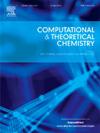质子-π相互作用及其在增强苯并[h]喹啉胺碱度中的作用的DFT见解
IF 3
3区 化学
Q3 CHEMISTRY, PHYSICAL
引用次数: 0
摘要
本研究利用量子化学方法研究了一系列碳-6上含有芳基的苯并[H]喹啉衍生物分子内质子-π (H+…π)相互作用的性质和强度。主要目的是阐明这些相互作用在稳定共轭酸中的作用及其对所涉及环芳香性的影响。采用CPCM模型,在气相和溶剂环境下的B3LYP/ 6-311 + G(d,p)水平上进行密度泛函理论计算。热力学分析表明,在芳基环上加入供电子取代基后,化合物5的质子亲和度和气相碱度显著增加,如化合物5的质子亲和度超过1000 kJ/mol的氨基。相反,电子密度低的吸电子基团(如硝基)或杂芳环明显降低了这些值。基于原子分子结构的拓扑分析确定了质子与芳族碳原子之间的键临界点,电子密度ρ(r)和势能密度V(r)值表明中等到强的H+…π相互作用(20-26 kJ/mol)。共轭酸[4 + H]+和[5 + H]+的相互作用最强。芳香性指数(包括HOMA、BI、PLR、PDI和sa)一致表明,与中性物种相比,芳香性显著降低,质子化后环畸变增加。最后,溶剂效应表明,质子化倾向和共轭酸稳定性在极性溶剂(如水)中增加,而在非极性介质中变化不太明显。总的来说,这些结果为芳香族体系中分子内H+…π相互作用的存在和重要性提供了强有力的证据,突出了它们在共轭酸稳定、芳香性降低和电子密度重分布中的重要作用。本文章由计算机程序翻译,如有差异,请以英文原文为准。
![DFT insights into proton–π interactions and their role in enhancing the basicity of benzo[h]quinoline amines](https://img.booksci.cn/booksciimg/2025-10/108322567751793329328.jpg)
DFT insights into proton–π interactions and their role in enhancing the basicity of benzo[h]quinoline amines
In this study, the nature and strength of intramolecular proton–π (H+…π) interactions in a series of benzo [h]quinoline derivatives bearing an aryl group at carbon-6 were investigated using quantum chemical methods. The primary goal was to clarify the role of these interactions in stabilizing conjugate acids and their effects on the aromaticity of the involved rings. Density Functional Theory calculations were performed at the B3LYP/6–311 + G(d,p) level in the gas phase and solvent environments using the CPCM model. Thermodynamic analysis showed that proton affinity and gas-phase basicity significantly increased in the presence of electron-donating substituents on the aryl ring, such as amino group with proton affinity exceeding 1000 kJ/mol for compound 5. In contrast, electron-withdrawing groups (e.g., nitro group) or heteroaromatic rings with low electron density notably decreased these values. Topological analysis based on the Atoms in Molecules framework confirmed bond critical points between the proton and aromatic carbon atoms, with electron density ρ(r) and potential energy density V(r) values indicating medium to strong H+…π interactions (20–26 kJ/mol). The strongest interactions were observed in the conjugate acids [4 + H]+ and [5 + H]+. Aromaticity indices-including HOMA, BI, PLR, PDI, and SA-consistently demonstrated a significant decrease in aromaticity and increased ring distortion upon protonation compared to neutral species. Finally, solvent effects showed that protonation tendency and conjugate acid stability increased in polar solvents such as water, while changes were less pronounced in nonpolar media. Overall, these results provide strong evidence for the presence and importance of intramolecular H+…π interactions in aromatic systems, highlighting their crucial role in conjugate acid stabilization, aromaticity reduction, and electronic density redistribution.
求助全文
通过发布文献求助,成功后即可免费获取论文全文。
去求助
来源期刊

Computational and Theoretical Chemistry
CHEMISTRY, PHYSICAL-
CiteScore
4.20
自引率
10.70%
发文量
331
审稿时长
31 days
期刊介绍:
Computational and Theoretical Chemistry publishes high quality, original reports of significance in computational and theoretical chemistry including those that deal with problems of structure, properties, energetics, weak interactions, reaction mechanisms, catalysis, and reaction rates involving atoms, molecules, clusters, surfaces, and bulk matter.
 求助内容:
求助内容: 应助结果提醒方式:
应助结果提醒方式:


